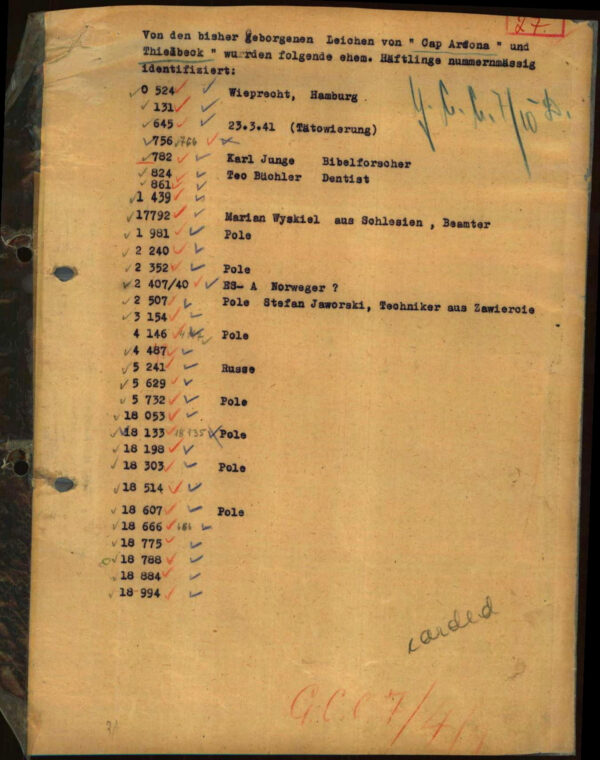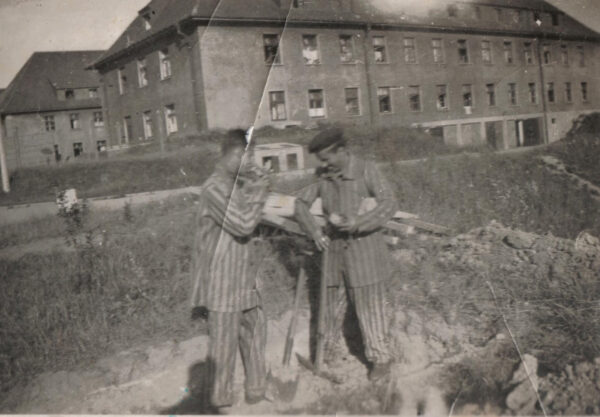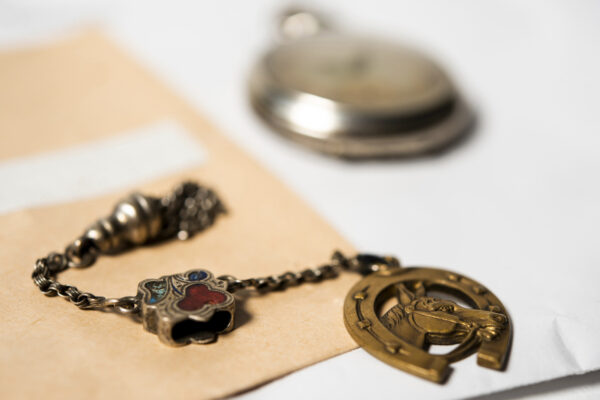#everynamecounts: New information on survivors of the Cap Arcona?

One of the world’s worst maritime disasters was the sinking of the Cap Arcona and the Thielbek on May 3, 1945, in the Bay of Lübeck. The Allies bombed the ships by mistake. Most of the people on board were concentration camp prisoners like Dariusz Wiaderek and Kazimierz Biel. They were just 21 and 23 years old. While Dariusz managed to swim ashore, Kazimierz died in the water. Who else was on board? Where did they all come from? We have joined forces with the municipal archives of Neustadt in Holstein to look for answers to these questions in a special card file. It comes from a post-war camp and contains 19,200 cards. Some of the people accommodated in the camp were survivors of the disaster. Who were they? As part of a new #everynamecounts drive, we are appealing for volunteers to help digitize the index cards in this file.
At the end of April 1945, the final days of the Second World War had arrived. The SS were driving survivors from various concentration camps on death marches to Holstein – one of the few parts of the German Reich they could still retreat to. Kazimierz Biel was on one of these marches. He was born in Krakow in 1921 and was just 19 years old when the National Socialists deported him to the Neuengamme concentration camp. Now, he and 7,000 other people crammed together on several ships off the coast of Neustadt were waiting to be liberated by the Allies.

The only thing Kazimierz Biel’s family have to remember him by is his student ID card with his photo and other personal documents that were stored in our archives for decades. The Nazis confiscated all his personal belongings when he was arrested. In 2018, we were able to return the mementoes to his nieces and nephews, who never got to know their uncle. (Photo: Arolsen Archives/ Cornelis Gollhardt)
Fatal mistake at the end of the war
Kazimierz was probably on board the passenger ship Cap Arcona, when British planes dropped bombs in the bay on May 3, thinking the concentration camp ships that were anchored offshore were naval ships. The Cap Arcona and the Thielbek – a freighter – caught fire and capsized. Kazimierz did not have a chance, he went down with the Cap Arcona. Over 6,500 people died. The Allies were able to identify Kazimierz by name because of his prisoner number, and he was later buried in Haffkrug cementry in the Bay of Lübeck.

List of the identified bodies recovered after the disaster, scan stored in the Arolsen Archives (Photo: https://collections.arolsen-archives.org/de/document/3413431)
Like Kazimierz, most of them were prisoners from Neuengamme concentration camp, while a few hundred came from Auschwitz-Fürstengrube. Only a few made it ashore. Many of them were shot in the water by the SS. Dariusz Wiaderek was lucky. The 21-year-old escaped from the Thielbek and avoided the Nazi henchmen.
Camp provides temporary accommodation for survivors
After the liberation, Dariusz and the survivors of the maritime disaster and the death marches stayed in Neustadt. At first, he was sent to a camp that had been set up by the Allies. This camp also housed other so-called displaced persons (DPs) – former concentration camp prisoners, forced laborers, and Jews – who were waiting for an opportunity to return to their home countries or emigrate. Dariusz emigrated to Sweden, but returned to Warsaw later on.

Extract from the list of the Jewish residents of Neustadt DP camp in Holstein, dated May 15, 1947 (Photo: https://collections.arolsen-archives.org/de/document/82019536)
Card file from post-war camp contains information about survivors
The main part of the camp was located in the barracks buildings of the former German submarine school on the Wieksberg. Some people were also accommodated in private apartments in the neighboring villages of Scharbeutz, Sierksdorf, and Timmendorfer Strand on the Baltic coast. Medical facilities, a children’s home, and various schools were also set up locally for survivors of Nazi persecution during this period.

Two Greek nationals in front of the former naval barracks on the Wieksberg in Neustadt in Holstein. Both men are wearing prisoner clothing from Neuengamme concentration camp. Not long before this picture was taken, they had been taken from the Hamburg concentration camp and forced to board the Cap Arcona, which lay at anchor in the Bay of Lübeck; they survived the disaster. The photo was probably taken in May 1945. (Photo: Kostas Chalemos, Greece)
The DP camp remained in existence until 1950 and sometimes provided accommodation for up to 4,000 people. Their personal details are recorded in a card file held by the municipal archives of Neustadt in Holstein that contains 19,200 cards. Which of the camp’s residents were survivors of the disaster? Where did the others come from? Which concentration camp had they been held in, where had they performed forced labor, and who for? The #everynamecounts campaign will help researchers find the answers to questions like these.
New documentation center in Neustadt in Holstein
The results will also be incorporated into the work of a new documentation center on the Cap Arcona disaster, which is currently being built by the town of Neustadt in Holstein with support from the German government and the state of Schleswig-Holstein. The permanent exhibition, which will cover around 300 square meters, will provide information about the fates that befell thousands of concentration camp prisoners from all over Europe in the Bay of Lübeck and in Neustadt on May 3, 1945. The main target audience of the documentation center will be teenagers and young adults, most of whom will visit the Documentation Center on a school trip or with a group focused on historical-political education.
Searching for relatives of victims of the maritime disaster
We still have personal items belonging to a few dozen victims of the disaster like Kazimierz and Dariusz. In all, the Arolsen Archives have over 2,000 envelopes containing the personal belongings of former concentration camp inmates. They belong to the families of the victims, not to us. We draw attention to this fact in our #StolenMemory traveling exhibition. The exhibition, which is accommodated in a shipping container, is in Neustadt in Holstein from April 26 to May 14. Visitors will find it on the market square. It is part of a series of events being held to mark the anniversary of the sinking of the ships.

Theophilos Simonides was also on board the Cap Arcona. We tell his story in the #StolenMemory traveling exhibition. He died before the bombing, after only three days on board, due to the insanitary conditions on the ship. We are still trying to trace his relatives! (Photo: Arolsen Archives)


